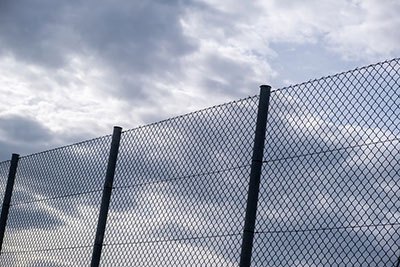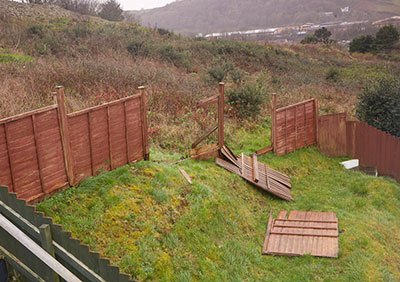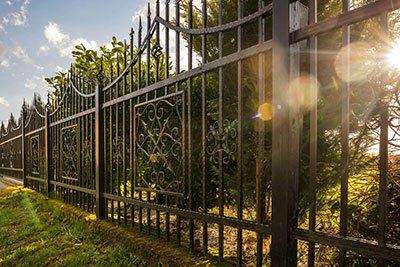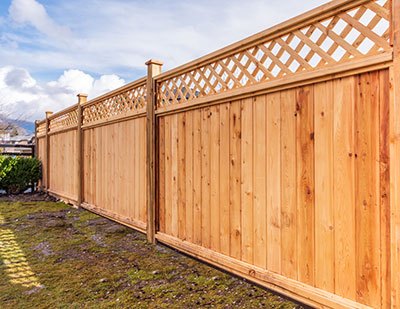Building a fence to protect your home is an important project that requires careful consideration. Furthermore, those located in areas prone to heavy winds must take into account how their chosen fence might stand up against the elements.
This post tackles this difficult matter head-on by providing essential information on which type of fence would withstand a strong wind most effectively.
Take away key points:
- Wire mesh fencing is an ideal type for windy areas, as the most effective solution
- There are various other fencing types to resist winds – vinyl coatings, wood, steel, metal, concrete, etc.
- Below you can find a detailed explanation of all these types
Table of Contents
The best wind-resistant fencing system for your needs!
If you live in a windy area with windy storms or hurricane winds, you need a fence withstanding high winds. So read on to learn to find the best wind-resistant fence for your needs.

1. Chain link fences
Chain link fences are popular fence types for security purposes and are particularly resistant to high winds due to the gaps in their structure which allow winds to pass through without resistance.
Chain link fence styles are also made of a strong material that is less susceptible to sagging or becoming fragile. Additionally, because chain link is made of metal, it is durable and can withstand wind and other weather conditions. A protective coating can be applied to further extend its lifespan.
Compared to other solid fences, chain link is relatively inexpensive with costs varying between $12 to $33 per linear foot depending on factors such as height, gauge, and coating.
Though chain link windproof fence does not offer any privacy, privacy slats can be added in different colors. However, this will also make the fence less wind-resistant. Additionally, chain link for high wind resistance requires almost no maintenance.
2. Vinyl fence
When it comes to privacy fencing, vinyl is an exception since it is highly flexible and can provide full privacy. Reinforcing a vinyl fence with metal fasteners can further increase its strength and durability. So, the new fence system is an ideal option that withstands high winds. It’s also ideal for areas where privacy is a priority.
The synthetic materials used in vinyl fences make them impervious to rain, snow, rot, and pests, while their flexible structure allows them to withstand strong winds.
Vinyl fences are low-maintenance and only require periodic pressure washing to keep them free of dirt, mold, and mildew. Various privacy variations are available in different styles of vinyl fences, offering a wide range of privacy options.
Although vinyl fences may be more expensive than other materials, they are typically long-lasting and easy to care for, with costs ranging from $17 to $38 per linear foot. For a standard-size wind-proof fence, the cost typically ranges between $2,181 to $6,089, with an average cost of $4,135.
3. Metal fences
Metal fences are durable, low-maintenance, and long-lasting wind-proof constructions, well-suited for high-wind areas. A solid fence includes aluminum, wrought iron, and steel options.
Metal fences have large gaps, so they do not offer complete privacy as other wind-resistance fence models do. However, the design options are practically limitless, providing some semi-private options.
Metal fences are reliable and powerful for hurricane straps, and high wind gusts, requiring little to no maintenance, similar to chain link fences. Although no structure is completely weatherproof, metal fences come close, and most are manufactured with a protective coating that makes them nearly rustproof in windy areas.
The cost of metal fences for windy areas varies based on the type of metal used. Aluminum fencing withstanding wind ranges from $19 to $76 per linear foot, with costs for a standard fence ranging from $3,111 to $6,753.
For wrought iron fences, the cost per linear foot is between $26 and $34, with a cost range of $2,334 to $4,769 for a standard fence.
4. Wood fence

A wood fence offers many design choices to consider for high winds, making it an excellent option beyond the standard full-privacy fence. Additionally, there are several wood types to choose from, including Cedar fences, Redwood fences, and Cypress fences to withstand high winds.
However, this solid fence type is among the most vulnerable fencing material when it comes to weather damage. The fence is not as sturdy as metal or vinyl and is susceptible to rot and pests. Therefore, it’s essential to select a wooden privacy fence to withstand the prevailing weather conditions in your area.
Fortunately, there are ways to fortify and protect your wooden privacy fence, including using concrete to secure posts, replacing loose boards and nails, and adding fencing preservatives.
For wood fences to retain their appearance, you should stain, paint, and regularly maintain them to check for wear, cracks, breaks, and damage. Wooden fences come in many design choices, including shadowbox for faux privacy or picket for semi-privacy.
Full-privacy fences are not recommended due to their poor wind resistance. The total expense of a wooden fence may vary depending on the lumber used, with homeowners typically paying between $14 to $31 per linear foot, or $1,996 to $4,448 for standard-size full-privacy fences.
5. Fence panels
Slatted fence panels may be a perfect choice for a balance between privacy and wind resistance. They have horizontal boards are fixed in rows, with a small gap between each board that allows wind to pass through.
This type of privacy fence offers more privacy than other wind-resistant styles and gives off a contemporary and stylish feel- perfect for high-wind areas.
Hit & Miss Fence Panels are another great option for this purpose, as their alternating boards give some spacing between them to let air pass through, while from the outside it still looks solid. To add some flair, a trellis fence-type boarding can be added on top.
However, since the gaps between the boards aren’t substantial enough even for light winds, this fencing style isn’t recommended for especially powerful gusts.
What makes your existing fence withstand high winds?
The crucial factors to consider so that our fence withstands high winds are its design and materials. But, you must also consider:
1. Fence posts

Posts are crucial for a fence, and choosing materials for them is a significant factor in the fence’s stability and longevity. Posts made of strong and rot-resistant materials will help the fence withstand the test of time.
You can get timber posts for more strength. Timber posts/wooden posts are also typically cheaper than concrete posts.
Metal and concrete posts are the ideal choices due to their strength and ability to resist decay caused by moisture or pests. Still, they are more expensive than harder wood models.
To increase the durability and stability of posts, you can use the concrete footing as a strong anchor for proper installation. Additionally, the use of stakes and brackets can provide further security to the post-anchor foundation.
It is recommended to plant the footers at a minimum of 30 inches into the ground for optimal anchoring and stability of the wind-resistant fence.
3. Materials
Using strong fence materials is a crucial step to withstand high winds. The use of materials such as chain link, vinyl, metal, and wood can create a sturdy fencing style. The fence easily withstands strong winds.
However, if you opt for weak materials, it will lead to a weak fence that can quickly fall with even minor winds, similar to a house of cards. So, only a windproof fence, installed properly can bear little or no damage from strong winds.
4. Post spacing/slat
Maintaining a 2-3 inch gap between vertical slats is an effective method, so the fence withstands high winds easily.
Do not use fewer posts are they will not secure your fences. Custom fence posts should be spaced not more than 7 feet apart, with a spacing of 5 to 6 feet for optimum wind sturdiness.
5. Advanced design
Low wind resistance is a crucial factor in achieving optimal fence strength. Fence designs that incorporate gaps allow wind to pass through, with larger spacing promoting better airflow.
Conversely, various fences with minimal or no gaps create a barrier that wind gusts can quickly batter down. You must balance wind-resistant designs with other necessary features such as privacy, curb appeal, and cost.
Finding the perfect balance among these will help to create a fence that not only looks beautiful but can also withstand the strongest of high winds. The fence systems will forbid wind to pass or blow freely through the structure and cause harm.
Best fence models for high winds
Here are some of the advanced fencing models for high winds:
1. Picket fence
Picket fences offer a semi-private option, which means some minimal privacy without complete isolation. Their design includes gaps that allow wind to pass through, making it more resistant to wind and other weather conditions. These fences have a classic appearance that is widely recognizable and enjoyed by many.
2. Shadowbox
The shadowbox design provides the appearance of full privacy, even though slats are spaced for ventilation and airflow. The fence boasts an intriguing three-dimensional appearance that creates visual interest.
Because this design has some gaps, it is more prone to wind damage than other fence designs. If you choose wood for this style of fence, you should contemplate opting for a hardwood option.
3. Trellis fences
Gaps in between the slats allow wind to pass through, meaning it’s more resistant to wind damage than other styles. As the gaps provide less privacy than other designs, it’s best suited to semi-private spaces where you don’t require complete isolation. It’s also possible to use the lattice design to grow plants up against the wall and create a living wall or trellis
4. Louvered fences
Depending on the angle of the slats, it may be more prone to wind damage than other designs. As such, if you choose wood, a hardwood option is recommended. The unique look and eye-catching design of this style make it stand out amongst other fencing options.
Enhancing your current fence

Follow the steps below for the best fence deals:
– Protection from damage – trimming branches, cleaning from weeds, and similar maintenance tips will provide a better fence condition
– Adding support – the methods can reinforce your fence rails and will not let the wind pass easily
– Replacing posts – you might need to replace the wooden privacy fences and posts to prevent damage or if you notice harm. You will reserve the whole construction.
FAQs
Do fences need gaps for the wind?
Yes, as they will release the wind pressure.
What fencing is best for high winds?
The best one is the wire mesh fencing or chain link model, but steel fences are also a great option.
How do you secure a fence in high winds?
You must apply heavy-duty slotted fencing posts.
How much wind can a wood fence withstand?
It withstands 60 mph without any issues.
Summary
The best fence model is the wire mesh fencing or chain link. So, ensure you pick these solutions to ensure the highest resistance to the wind head-on.

